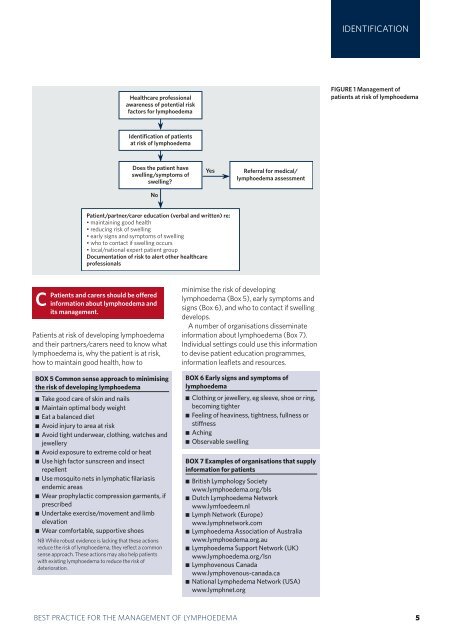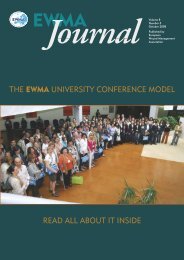best practice for the management of lymphoedema ... - EWMA
best practice for the management of lymphoedema ... - EWMA
best practice for the management of lymphoedema ... - EWMA
Create successful ePaper yourself
Turn your PDF publications into a flip-book with our unique Google optimized e-Paper software.
C Patients<br />
Healthcare pr<strong>of</strong>essional<br />
awareness <strong>of</strong> potential risk<br />
factors <strong>for</strong> <strong>lymphoedema</strong><br />
Identification <strong>of</strong> patients<br />
at risk <strong>of</strong> <strong>lymphoedema</strong><br />
Does <strong>the</strong> patient have<br />
swelling/symptoms <strong>of</strong><br />
swelling?<br />
No<br />
Patients at risk <strong>of</strong> developing <strong>lymphoedema</strong><br />
and <strong>the</strong>ir partners/carers need to know what<br />
<strong>lymphoedema</strong> is, why <strong>the</strong> patient is at risk,<br />
how to maintain good health, how to<br />
Yes<br />
Patient/partner/carer education (verbal and written) re:<br />
• maintaining good health<br />
• reducing risk <strong>of</strong> swelling<br />
• early signs and symptoms <strong>of</strong> swelling<br />
• who to contact if swelling occurs<br />
• local/national expert patient group<br />
Documentation <strong>of</strong> risk to alert o<strong>the</strong>r healthcare<br />
pr<strong>of</strong>essionals<br />
and carers should be <strong>of</strong>fered<br />
in<strong>for</strong>mation about <strong>lymphoedema</strong> and<br />
its <strong>management</strong>.<br />
BOX 5 Common sense approach to minimising<br />
<strong>the</strong> risk <strong>of</strong> developing <strong>lymphoedema</strong><br />
■ Take good care <strong>of</strong> skin and nails<br />
■ Maintain optimal body weight<br />
■ Eat a balanced diet<br />
■ Avoid injury to area at risk<br />
■ Avoid tight underwear, clothing, watches and<br />
jewellery<br />
■ Avoid exposure to extreme cold or heat<br />
■ Use high factor sunscreen and insect<br />
repellent<br />
■ Use mosquito nets in lymphatic filariasis<br />
endemic areas<br />
■ Wear prophylactic compression garments, if<br />
prescribed<br />
■ Undertake exercise/movement and limb<br />
elevation<br />
■ Wear com<strong>for</strong>table, supportive shoes<br />
NB While robust evidence is lacking that <strong>the</strong>se actions<br />
reduce <strong>the</strong> risk <strong>of</strong> <strong>lymphoedema</strong>, <strong>the</strong>y reflect a common<br />
sense approach. These actions may also help patients<br />
with existing <strong>lymphoedema</strong> to reduce <strong>the</strong> risk <strong>of</strong><br />
deterioration.<br />
Referral <strong>for</strong> medical/<br />
<strong>lymphoedema</strong> assessment<br />
minimise <strong>the</strong> risk <strong>of</strong> developing<br />
<strong>lymphoedema</strong> (Box 5), early symptoms and<br />
signs (Box 6), and who to contact if swelling<br />
develops.<br />
A number <strong>of</strong> organisations disseminate<br />
in<strong>for</strong>mation about <strong>lymphoedema</strong> (Box 7).<br />
Individual settings could use this in<strong>for</strong>mation<br />
to devise patient education programmes,<br />
in<strong>for</strong>mation leaflets and resources.<br />
BOX 6 Early signs and symptoms <strong>of</strong><br />
<strong>lymphoedema</strong><br />
■ Clothing or jewellery, eg sleeve, shoe or ring,<br />
becoming tighter<br />
■ Feeling <strong>of</strong> heaviness, tightness, fullness or<br />
stiffness<br />
■ Aching<br />
■ Observable swelling<br />
BOX 7 Examples <strong>of</strong> organisations that supply<br />
in<strong>for</strong>mation <strong>for</strong> patients<br />
■ British Lymphology Society<br />
www.<strong>lymphoedema</strong>.org/bls<br />
■ Dutch Lymphoedema Network<br />
www.lymfoedeem.nl<br />
■ Lymph Network (Europe)<br />
www.lymphnetwork.com<br />
■ Lymphoedema Association <strong>of</strong> Australia<br />
www.<strong>lymphoedema</strong>.org.au<br />
■ Lymphoedema Support Network (UK)<br />
www.<strong>lymphoedema</strong>.org/lsn<br />
■ Lymphovenous Canada<br />
www.lymphovenous-canada.ca<br />
■ National Lymphedema Network (USA)<br />
www.lymphnet.org<br />
IDENTIFICATION<br />
FIGURE 1 Management <strong>of</strong><br />
patients at risk <strong>of</strong> <strong>lymphoedema</strong><br />
BEST PRACTICE FOR THE MANAGEMENT OF LYMPHOEDEMA 5

















